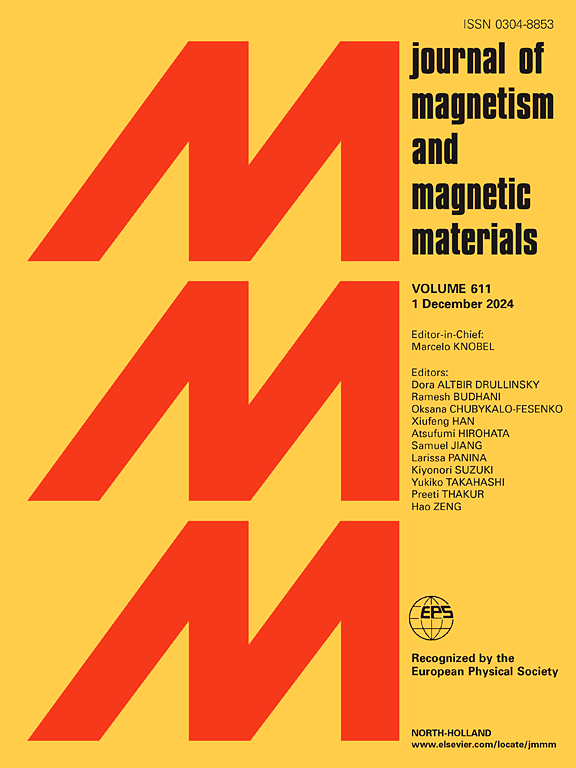利用锌空位对纤维状锌矿中ZnO磁性机理的第一性原理研究
IF 2.5
3区 材料科学
Q3 MATERIALS SCIENCE, MULTIDISCIPLINARY
引用次数: 0
摘要
目前,锌(Zn)空位对纤维状锌矿ZnO磁性机制的影响(来自文献的误判:J. Magn.;粉剂。Mater. 603[2024] 172227)是有争议的。为了解决这一问题,本研究采用第一性原理密度泛函理论+ Hubbard U方法研究了锌空位对纤化ZnO磁性机制的影响,结果表明,在富氧条件下,锌空位比富锌条件下更容易在ZnO中形成。具有自旋极化的O1—2p态是Zn35O36体系磁性能的来源。与没有自旋极化的O2—2p态不同,自旋极化的O1—2p态具有局域电子和漫游电子(受体和给体)的双重性质。自旋极化的O1—2p态与实验结果一致。该模型有望阐明纤维状ZnO结构半导体中类似阳离子空位的磁性机制。本文章由计算机程序翻译,如有差异,请以英文原文为准。
First-principles study of the mechanism of ZnO magnetism in fibrillar zinc ore by zinc vacancies
Currently, the influence of zinc (Zn) vacancies on the magnetic mechanism of fibrillar zincite ZnO (misjudgment from literature: J. Magn. Magn. Mater. 603 [2024] 172227) is controversial. To solve this problem, this study investigates the effect of Zn vacancies on the magnetic mechanism of fibrillated ZnO by using a first-principles density functional theory + Hubbard U approach, which shows that Zn vacancies are more likely to form in ZnO under oxygen-rich conditions than under Zn-rich conditions. The O1-–2p state with spin polarization is the source of the magnetic properties of the Zn35O36 system. Unlike the O2-–2p state without spin polarization, the spin-polarized O1-–2p state has the dual property of localized and roaming electrons (acceptor and donor). The spin-polarized O1-–2p states agree with the experimental results. This model is expected to elucidate the magnetic mechanism of similar cationic vacancies in fibrillar ZnO structured semiconductors.
求助全文
通过发布文献求助,成功后即可免费获取论文全文。
去求助
来源期刊

Journal of Magnetism and Magnetic Materials
物理-材料科学:综合
CiteScore
5.30
自引率
11.10%
发文量
1149
审稿时长
59 days
期刊介绍:
The Journal of Magnetism and Magnetic Materials provides an important forum for the disclosure and discussion of original contributions covering the whole spectrum of topics, from basic magnetism to the technology and applications of magnetic materials. The journal encourages greater interaction between the basic and applied sub-disciplines of magnetism with comprehensive review articles, in addition to full-length contributions. In addition, other categories of contributions are welcome, including Critical Focused issues, Current Perspectives and Outreach to the General Public.
Main Categories:
Full-length articles:
Technically original research documents that report results of value to the communities that comprise the journal audience. The link between chemical, structural and microstructural properties on the one hand and magnetic properties on the other hand are encouraged.
In addition to general topics covering all areas of magnetism and magnetic materials, the full-length articles also include three sub-sections, focusing on Nanomagnetism, Spintronics and Applications.
The sub-section on Nanomagnetism contains articles on magnetic nanoparticles, nanowires, thin films, 2D materials and other nanoscale magnetic materials and their applications.
The sub-section on Spintronics contains articles on magnetoresistance, magnetoimpedance, magneto-optical phenomena, Micro-Electro-Mechanical Systems (MEMS), and other topics related to spin current control and magneto-transport phenomena. The sub-section on Applications display papers that focus on applications of magnetic materials. The applications need to show a connection to magnetism.
Review articles:
Review articles organize, clarify, and summarize existing major works in the areas covered by the Journal and provide comprehensive citations to the full spectrum of relevant literature.
 求助内容:
求助内容: 应助结果提醒方式:
应助结果提醒方式:


